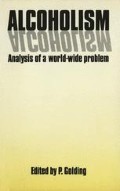Abstract
In alcoholic and chemically dependent families, we have found a significant correlation with intimacy dysfunction. Intimacy dysfunction is defined as an inability to express feelings (both positive and negative) in a meaningful and constructive manner, which is mutually acceptable and respectful, and leads to the psychological well-being of the individuals involved. In order to engage in intimate behaviour or to be involved in an intimate relationship, one must be able to communicate feelings and thoughts. The purpose of this communication is to define the boundaries of the relationship and to express feelings of caring, concern, commitment. It is to negotiate roles and rules of the relationship and to resolve conflicts. Intimacy dysfunction is also an attitudinal dysfunction which prevents the individual from having meaningful relationships.
Access this chapter
Tax calculation will be finalised at checkout
Purchases are for personal use only
Preview
Unable to display preview. Download preview PDF.
References
Coleman, E. (1982). Family intimacy and chemical abuse: The connection. J. Psychoact. Drugs, 14, 153
Mason, M. (1983). Sexuality and fear of intimacy as barriers for recovery for drug dependent women. In Reed, B., Beshner, C. and Mondanaro, J. (eds.) Treatment Services for Drug Dependent Women, Vol. II. (Washington, DC: US Govt Printing Office, for US Dept of Health and Human Services)
Kempe, C. H., Silverman, F. N., Steele, B. F., Droegemulle, W. and Silver, H. K. (1962). The battered child syndrome. J. Am. Med. Assoc., 181, 17
Benward, J. and Densen-Gerber, J. (1975). Incest as a causative factor in anti-social behaviour: An exploratory study. Contemp. Drug Probl., 4, 323
Wilsniak, S. C. (1976). The impact of sex roles on women’s alcohol use and abuse. In Greenblatt, M. and Schuckit, M. A. (eds.) Alcoholism Problems in Women and Children. (New York: Grune & Stratton)
Fifield, L. (1975). On My Way to Nowhere: Alienated, Isolated, Drunk. (Los Angeles: Gay Community Services Center)
Editor information
Editors and Affiliations
Rights and permissions
Copyright information
© 1983 MTP Press Limited
About this chapter
Cite this chapter
Coleman, E. (1983). Sexuality and the alcoholic family. In: Golding, P. (eds) Alcoholism. Springer, Dordrecht. https://doi.org/10.1007/978-94-009-6607-9_37
Download citation
DOI: https://doi.org/10.1007/978-94-009-6607-9_37
Publisher Name: Springer, Dordrecht
Print ISBN: 978-94-009-6609-3
Online ISBN: 978-94-009-6607-9
eBook Packages: Springer Book Archive

